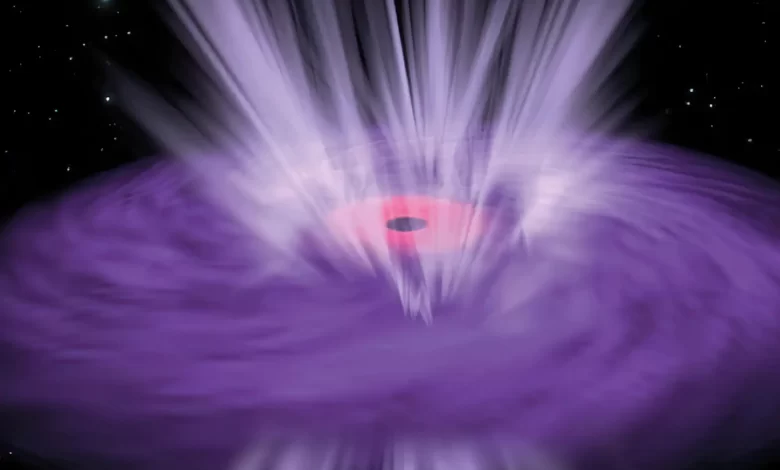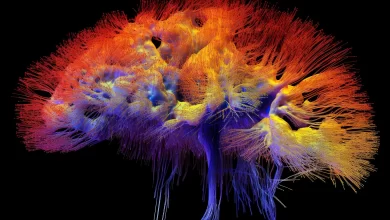„UFOs“ – Die ultraschnellen Weltraumwinde, die die Entwicklung von Galaxien prägen

[ad_1]

Künstlerische Ansicht von mehrphasigen AGN-getriebenen Winden, die die verschiedenen Phasen und Größenordnungen hervorheben, die am Ausfluss beteiligt sind. Der Wind breitet sich vom Zentralmotor (< 1 pc; a) durch das umgebende ISM (1 pc–1 kpc; b) bis zu den Grenzen der Wirtsgalaxie aus (> 10 kpc; c). SUBWAYS wird den Ausfluss in seiner Startphase untersuchen, wenn das Gas stark ionisiert ist und das Vorhandensein von sich schnell bewegendem Material in Röntgenstrahlen nachgewiesen werden kann. (Abbildung übernommen von Cicone et al. 2018, Nat. As. 2, 176). Bildnachweis: Universität Bologna
Sie werden UFOs genannt, aber Außerirdische haben nichts mit ihnen zu tun. Es handelt sich um die ultraschnellen Ausflüsse: Weltraumwinde, die aus der Umgebung supermassereicher Schwarzer Löcher auftauchen und mit Geschwindigkeiten nahe der Lichtgeschwindigkeit wehen. Ein internationales Forschungsteam hat dieses noch wenig verstandene Phänomen untersucht und nach diesen Gasemissionen gesucht, die für das Verständnis der Mechanismen, die das Verhalten supermassereicher Schwarzer Löcher in ihrer aktiven Phase regulieren, von entscheidender Bedeutung sind.
Das Forschungsprojekt heißt U-BAHNEN (SUpermassive Schwarze Löcher, Winde im Röntgenlicht) und die ersten Ergebnisse wurden in zwei Artikeln veröffentlicht Astronomie und Astrophysik. Die erste davon wurde von Wissenschaftlern der Universität Bologna und des INAF geleitet und basiert hauptsächlich auf Daten des ESA-Weltraumteleskops XMM-Newton.
Die Wissenschaftler analysierten 22 aktive galaktische Kerne (AGN), also die Regionen, die supermassereiche Schwarze Löcher im Zentrum von Galaxien umgeben und enorme Strahlungsmengen im gesamten elektromagnetischen Spektrum aussenden, wenn sich Schwarze Löcher in der aktiven Phase befinden. Die Untersuchung ergab, dass in etwa 30 % der untersuchten aktiven Galaxienkerne Weltraumwinde vorhanden sind, die sich mit Geschwindigkeiten zwischen 10 % und 30 % der Lichtgeschwindigkeit bewegen.
„Diese Ergebnisse ermöglichen es uns, mit größerer Sicherheit festzustellen, dass ein erheblicher Teil der aktiven galaktischen Kerne ultraschnelle Winde, sogenannte UFOs, ultraschnelle Ausflüsse, beherbergt“, erklärt Marcella Brusa, Professorin an der Universität Bologna und INAF-Mitarbeiterin sowie Koordinatorin des gesamten SUBWAYS-Projekts. „Und wir konnten bestätigen, dass die Intensität dieser Gasströme ausreicht, um das Ökosystem ihrer Galaxien erheblich zu verändern.“
Zwischen einem Supermassereichen[{” attribute=””>black hole and the galaxy that surrounds it, there is in fact a close relationship that reciprocally influences their formation and evolution. The mechanisms driving this reciprocal relationship are still poorly understood, but among the key ingredients may be the ultra-fast winds emitted by active galactic nuclei. These powerful emissions arise when part of the gas in the accretion disk is ejected outwards, thus transferring some of the matter and energy produced to interstellar space, a mechanism that has important implications for regulating the process of star formation.
In order to detect UFOs, spectra emitted in the X-ray band are analyzed, looking for absorptions produced by the presence of highly ionized materials such as iron. This phenomenon is due to the extreme temperatures – up to tens of millions of degrees – generated in the vicinity of supermassive black holes. With this in mind, SUBWAYS scientists managed to obtain 1.6 million seconds of observation time (more than eighteen days) with the ESA XMM-Newton X-ray Space Telescope. They thus explored 17 active galactic nuclei in the relatively nearby universe (between about 1.5 and 5 billion light years away), to which they added data from another 5 AGN already collected in previous observations.
“These observations have allowed us to obtain new independent evidence of the existence of highly ionized matter that is ejected from the innermost regions of active galactic nuclei at speeds close to that of light,” says Gabriele Matzeu, a researcher at the University of Bologna, INAF associate and first author of the paper presenting the results on UFOs statistics. “These outcomes have allowed us to learn more about these ultrafast winds and to better understand their role in shaping the evolution process of galaxies.”
A companion paper was also published in the journal Astronomy & Astrophysics that presents a study of lower-velocity and lower-ionization gas flows visible in the ultraviolet band thanks to the HST satellite.
References: “Supermassive Black Hole Winds in X-rays: SUBWAYS – I. Ultra-fast outflows in quasars beyond the local Universe” by G. A. Matzeu, M. Brusa, G. Lanzuisi, M. Dadina, S. Bianchi, G. Kriss, M. Mehdipour, E. Nardini, G. Chartas, R. Middei, E. Piconcelli, V. Gianolli, A. Comastri, A. L. Longinotti, Y. Krongold, F. Ricci, P. O. Petrucci, F. Tombesi, A. Luminari, L. Zappacosta, G. Miniutti, M. Gaspari, E. Behar, M. Bischetti, S. Mathur, M. Perna, M. Giustini, P. Grandi, E. Torresi, C. Vignali, G. Bruni, M. Cappi, E. Costantini, G. Cresci, B. De Marco, A. De Rosa, R. Gilli, M. Guainazzi, J. Kaastra, S. Kraemer, F. La Franca, A. Marconi, F. Panessa, G. Ponti, D. Proga, F. Ursini, P. Baldini, F. Fiore, A. R. King, R. Maiolino, G. Matt and A. Merloni, 28 February 2023, Astronomy & Astrophysics.
DOI: 10.1051/0004-6361/202245036
“Supermassive Black Hole Winds in X-rays: SUBWAYS – II. HST UV spectroscopy of winds at intermediate redshifts” by M. Mehdipour, G. A. Kriss, M. Brusa, G. A. Matzeu, M. Gaspari, S. B. Kraemer, S. Mathur, E. Behar, S. Bianchi, M. Cappi, G. Chartas, E. Costantini, G. Cresci, M. Dadina, B. De Marco, A. De Rosa, J. P. Dunn, V. E. Gianolli, M. Giustini, J. S. Kaastra, A. R. King, Y. Krongold, F. La Franca, G. Lanzuisi, A. L. Longinotti, A. Luminari, R. Middei, G. Miniutti, E. Nardini, M. Perna, P.-O. Petrucci, E. Piconcelli, G. Ponti, F. Ricci, F. Tombesi, F. Ursini, C. Vignali and L. Zappacosta, 28 February 2023, Astronomy & Astrophysics.
DOI: 10.1051/0004-6361/202245047
[ad_2]
Source link




